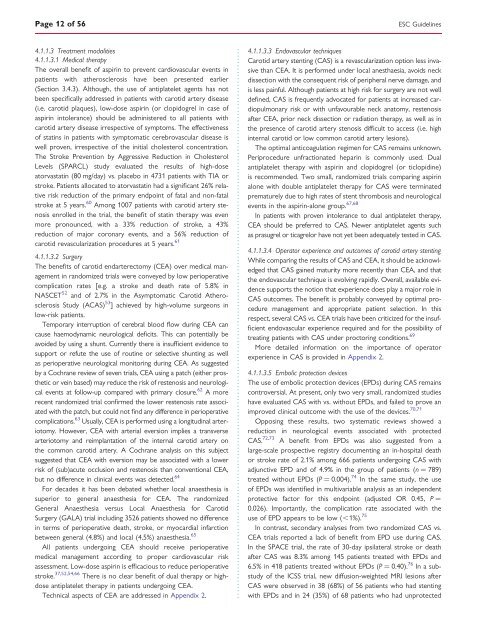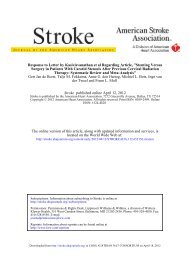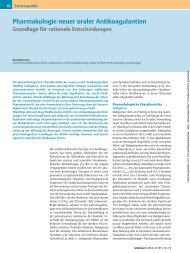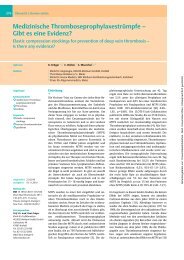ESC Guidelines on the diagnosis and treatment of peripheral artery ...
ESC Guidelines on the diagnosis and treatment of peripheral artery ...
ESC Guidelines on the diagnosis and treatment of peripheral artery ...
You also want an ePaper? Increase the reach of your titles
YUMPU automatically turns print PDFs into web optimized ePapers that Google loves.
Page 12 <strong>of</strong> 56<br />
4.1.1.3 Treatment modalities<br />
4.1.1.3.1 Medical <strong>the</strong>rapy<br />
The overall benefit <strong>of</strong> aspirin to prevent cardiovascular events in<br />
patients with a<strong>the</strong>rosclerosis have been presented earlier<br />
(Secti<strong>on</strong> 3.4.3). Although, <strong>the</strong> use <strong>of</strong> antiplatelet agents has not<br />
been specifically addressed in patients with carotid <strong>artery</strong> disease<br />
(i.e. carotid plaques), low-dose aspirin (or clopidogrel in case <strong>of</strong><br />
aspirin intolerance) should be administered to all patients with<br />
carotid <strong>artery</strong> disease irrespective <strong>of</strong> symptoms. The effectiveness<br />
<strong>of</strong> statins in patients with symptomatic cerebrovascular disease is<br />
well proven, irrespective <strong>of</strong> <strong>the</strong> initial cholesterol c<strong>on</strong>centrati<strong>on</strong>.<br />
The Stroke Preventi<strong>on</strong> by Aggressive Reducti<strong>on</strong> in Cholesterol<br />
Levels (SPARCL) study evaluated <strong>the</strong> results <strong>of</strong> high-dose<br />
atorvastatin (80 mg/day) vs. placebo in 4731 patients with TIA or<br />
stroke. Patients allocated to atorvastatin had a significant 26% relative<br />
risk reducti<strong>on</strong> <strong>of</strong> <strong>the</strong> primary endpoint <strong>of</strong> fatal <strong>and</strong> n<strong>on</strong>-fatal<br />
stroke at 5 years. 60 Am<strong>on</strong>g 1007 patients with carotid <strong>artery</strong> stenosis<br />
enrolled in <strong>the</strong> trial, <strong>the</strong> benefit <strong>of</strong> statin <strong>the</strong>rapy was even<br />
more pr<strong>on</strong>ounced, with a 33% reducti<strong>on</strong> <strong>of</strong> stroke, a 43%<br />
reducti<strong>on</strong> <strong>of</strong> major cor<strong>on</strong>ary events, <strong>and</strong> a 56% reducti<strong>on</strong> <strong>of</strong><br />
carotid revascularizati<strong>on</strong> procedures at 5 years. 61<br />
4.1.1.3.2 Surgery<br />
The benefits <strong>of</strong> carotid endarterectomy (CEA) over medical management<br />
in r<strong>and</strong>omized trials were c<strong>on</strong>veyed by low perioperative<br />
complicati<strong>on</strong> rates [e.g. a stroke <strong>and</strong> death rate <strong>of</strong> 5.8% in<br />
NASCET 52 <strong>and</strong> <strong>of</strong> 2.7% in <strong>the</strong> Asymptomatic Carotid A<strong>the</strong>rosclerosis<br />
Study (ACAS) 53 ] achieved by high-volume surge<strong>on</strong>s in<br />
low-risk patients.<br />
Temporary interrupti<strong>on</strong> <strong>of</strong> cerebral blood flow during CEA can<br />
cause haemodynamic neurological deficits. This can potentially be<br />
avoided by using a shunt. Currently <strong>the</strong>re is insufficient evidence to<br />
support or refute <strong>the</strong> use <strong>of</strong> routine or selective shunting as well<br />
as perioperative neurological m<strong>on</strong>itoring during CEA. As suggested<br />
by a Cochrane review <strong>of</strong> seven trials, CEA using a patch (ei<strong>the</strong>r pros<strong>the</strong>tic<br />
or vein based) may reduce <strong>the</strong> risk <strong>of</strong> restenosis <strong>and</strong> neurological<br />
events at follow-up compared with primary closure. 62 A more<br />
recent r<strong>and</strong>omized trial c<strong>on</strong>firmed <strong>the</strong> lower restenosis rate associated<br />
with <strong>the</strong> patch, but could not find any difference in perioperative<br />
complicati<strong>on</strong>s. 63 Usually, CEA is performed using a l<strong>on</strong>gitudinal arteriotomy.<br />
However, CEA with arterial eversi<strong>on</strong> implies a transverse<br />
arteriotomy <strong>and</strong> reimplantati<strong>on</strong> <strong>of</strong> <strong>the</strong> internal carotid <strong>artery</strong> <strong>on</strong><br />
<strong>the</strong> comm<strong>on</strong> carotid <strong>artery</strong>. A Cochrane analysis <strong>on</strong> this subject<br />
suggested that CEA with eversi<strong>on</strong> may be associated with a lower<br />
risk <strong>of</strong> (sub)acute occlusi<strong>on</strong> <strong>and</strong> restenosis than c<strong>on</strong>venti<strong>on</strong>al CEA,<br />
but no difference in clinical events was detected. 64<br />
For decades it has been debated whe<strong>the</strong>r local anaes<strong>the</strong>sia is<br />
superior to general anaes<strong>the</strong>sia for CEA. The r<strong>and</strong>omized<br />
General Anaes<strong>the</strong>sia versus Local Anaes<strong>the</strong>sia for Carotid<br />
Surgery (GALA) trial including 3526 patients showed no difference<br />
in terms <strong>of</strong> perioperative death, stroke, or myocardial infarcti<strong>on</strong><br />
between general (4.8%) <strong>and</strong> local (4.5%) anaes<strong>the</strong>sia. 65<br />
All patients undergoing CEA should receive perioperative<br />
medical management according to proper cardiovascular risk<br />
assessment. Low-dose aspirin is efficacious to reduce perioperative<br />
stroke. 37,52,54,66 There is no clear benefit <strong>of</strong> dual <strong>the</strong>rapy or highdose<br />
antiplatelet <strong>the</strong>rapy in patients undergoing CEA.<br />
Technical aspects <strong>of</strong> CEA are addressed in Appendix 2.<br />
<str<strong>on</strong>g>ESC</str<strong>on</strong>g> <str<strong>on</strong>g>Guidelines</str<strong>on</strong>g><br />
4.1.1.3.3 Endovascular techniques<br />
Carotid <strong>artery</strong> stenting (CAS) is a revascularizati<strong>on</strong> opti<strong>on</strong> less invasive<br />
than CEA. It is performed under local anesthaesia, avoids neck<br />
dissecti<strong>on</strong> with <strong>the</strong> c<strong>on</strong>sequent risk <strong>of</strong> <strong>peripheral</strong> nerve damage, <strong>and</strong><br />
is less painful. Although patients at high risk for surgery are not well<br />
defined, CAS is frequently advocated for patients at increased cardiopulm<strong>on</strong>ary<br />
risk or with unfavourable neck anatomy, restenosis<br />
after CEA, prior neck dissecti<strong>on</strong> or radiati<strong>on</strong> <strong>the</strong>rapy, as well as in<br />
<strong>the</strong> presence <strong>of</strong> carotid <strong>artery</strong> stenosis difficult to access (i.e. high<br />
internal carotid or low comm<strong>on</strong> carotid <strong>artery</strong> lesi<strong>on</strong>s).<br />
The optimal anticoagulati<strong>on</strong> regimen for CAS remains unknown.<br />
Periprocedure unfracti<strong>on</strong>ated heparin is comm<strong>on</strong>ly used. Dual<br />
antiplatelet <strong>the</strong>rapy with aspirin <strong>and</strong> clopidogrel (or ticlopidine)<br />
is recommended. Two small, r<strong>and</strong>omized trials comparing aspirin<br />
al<strong>on</strong>e with double antiplatelet <strong>the</strong>rapy for CAS were terminated<br />
prematurely due to high rates <strong>of</strong> stent thrombosis <strong>and</strong> neurological<br />
events in <strong>the</strong> aspirin-al<strong>on</strong>e group. 67,68<br />
In patients with proven intolerance to dual antiplatelet <strong>the</strong>rapy,<br />
CEA should be preferred to CAS. Newer antiplatelet agents such<br />
as prasugrel or ticagrelor have not yet been adequately tested in CAS.<br />
4.1.1.3.4 Operator experience <strong>and</strong> outcomes <strong>of</strong> carotid <strong>artery</strong> stenting<br />
While comparing <strong>the</strong> results <strong>of</strong> CAS <strong>and</strong> CEA, it should be acknowledged<br />
that CAS gained maturity more recently than CEA, <strong>and</strong> that<br />
<strong>the</strong> endovascular technique is evolving rapidly. Overall, available evidence<br />
supports <strong>the</strong> noti<strong>on</strong> that experience does play a major role in<br />
CAS outcomes. The benefit is probably c<strong>on</strong>veyed by optimal procedure<br />
management <strong>and</strong> appropriate patient selecti<strong>on</strong>. In this<br />
respect, several CAS vs. CEA trials have been criticized for <strong>the</strong> insufficient<br />
endovascular experience required <strong>and</strong> for <strong>the</strong> possibility <strong>of</strong><br />
treating patients with CAS under proctoring c<strong>on</strong>diti<strong>on</strong>s. 69<br />
More detailed informati<strong>on</strong> <strong>on</strong> <strong>the</strong> importance <strong>of</strong> operator<br />
experience in CAS is provided in Appendix 2.<br />
4.1.1.3.5 Embolic protecti<strong>on</strong> devices<br />
The use <strong>of</strong> embolic protecti<strong>on</strong> devices (EPDs) during CAS remains<br />
c<strong>on</strong>troversial. At present, <strong>on</strong>ly two very small, r<strong>and</strong>omized studies<br />
have evaluated CAS with vs. without EPDs, <strong>and</strong> failed to prove an<br />
improved clinical outcome with <strong>the</strong> use <strong>of</strong> <strong>the</strong> devices. 70,71<br />
Opposing <strong>the</strong>se results, two systematic reviews showed a<br />
reducti<strong>on</strong> in neurological events associated with protected<br />
CAS. 72,73 A benefit from EPDs was also suggested from a<br />
large-scale prospective registry documenting an in-hospital death<br />
or stroke rate <strong>of</strong> 2.1% am<strong>on</strong>g 666 patients undergoing CAS with<br />
adjunctive EPD <strong>and</strong> <strong>of</strong> 4.9% in <strong>the</strong> group <strong>of</strong> patients (n ¼ 789)<br />
treated without EPDs (P ¼ 0.004). 74 In <strong>the</strong> same study, <strong>the</strong> use<br />
<strong>of</strong> EPDs was identified in multivariable analysis as an independent<br />
protective factor for this endpoint (adjusted OR 0.45, P ¼<br />
0.026). Importantly, <strong>the</strong> complicati<strong>on</strong> rate associated with <strong>the</strong><br />
use <strong>of</strong> EPD appears to be low (,1%). 75<br />
In c<strong>on</strong>trast, sec<strong>on</strong>dary analyses from two r<strong>and</strong>omized CAS vs.<br />
CEA trials reported a lack <strong>of</strong> benefit from EPD use during CAS.<br />
In <strong>the</strong> SPACE trial, <strong>the</strong> rate <strong>of</strong> 30-day ipsilateral stroke or death<br />
after CAS was 8.3% am<strong>on</strong>g 145 patients treated with EPDs <strong>and</strong><br />
6.5% in 418 patients treated without EPDs (P ¼ 0.40). 76 In a substudy<br />
<strong>of</strong> <strong>the</strong> ICSS trial, new diffusi<strong>on</strong>-weighted MRI lesi<strong>on</strong>s after<br />
CAS were observed in 38 (68%) <strong>of</strong> 56 patients who had stenting<br />
with EPDs <strong>and</strong> in 24 (35%) <strong>of</strong> 68 patients who had unprotected







